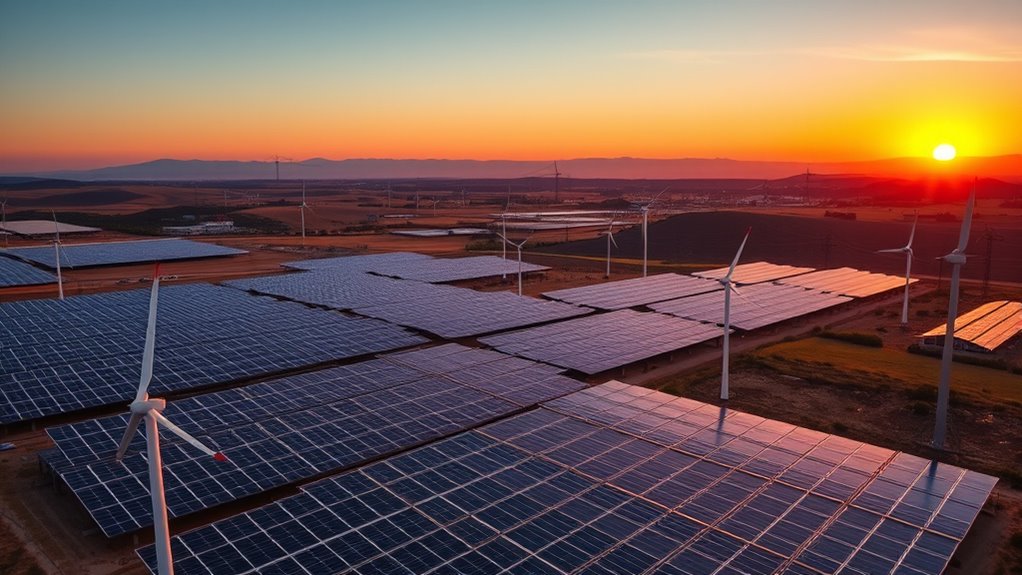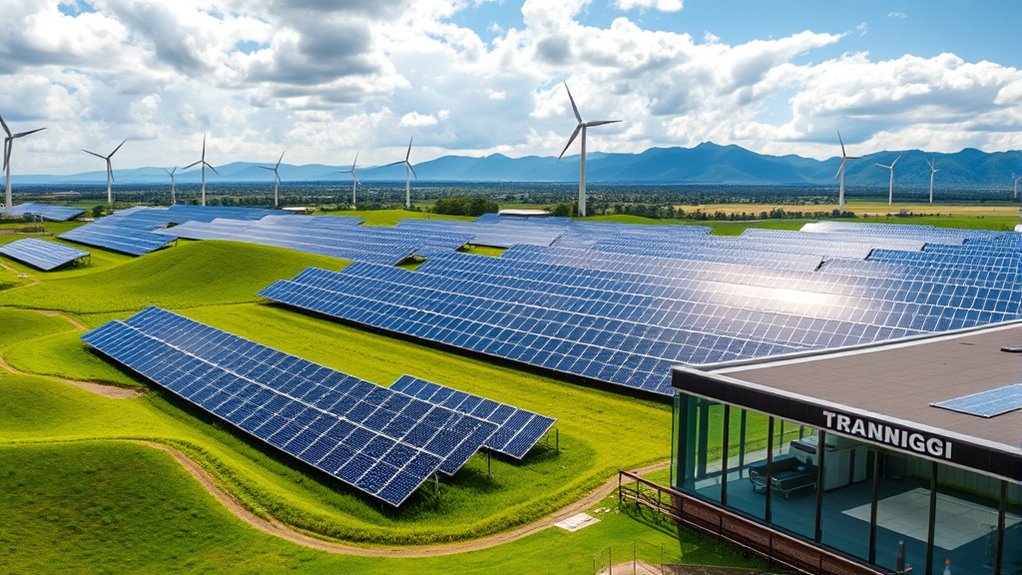Investing in renewable energy is increasingly vital as costs drop and government support expands, making it a promising, sustainable opportunity. You can choose from various financing options like leases, loans, and power purchase agreements to manage upfront costs and enhance cash flow. However, policy incentives and regulations vary by location and can change unexpectedly. Staying informed about the latest trends and steering through these challenges can boost your success in renewable energy investments, and there’s more to explore to maximize your benefits.
Key Takeaways
- Growing global investment in renewable energy, especially solar, driven by decreasing costs and supportive policies.
- Policy incentives like tax credits and net metering significantly influence project economics and investment returns.
- Diverse financing options, including leasing and loans, help reduce upfront costs and accelerate deployment.
- Regulatory landscape variability and policy changes pose challenges to stable investment planning.
- Due diligence and staying informed on evolving regulations are vital for managing risks in renewable energy investments.

Investing in renewable energy has become a vital step toward a sustainable future. As you explore opportunities in this rapidly evolving field, understanding the landscape of solar financing and policy incentives can significantly influence your decisions. Solar energy, in particular, has gained momentum because of its decreasing costs and expanding support from government programs. When you consider solar financing options, you’ll find a variety of models designed to make solar installations more accessible, whether through leasing, power purchase agreements, or loans. These options reduce upfront costs, allowing you to benefit from clean energy without the heavy initial investment. By leveraging solar financing, you can accelerate project deployment while managing cash flow effectively. Additionally, understanding the different types of eligible investments, such as those involving specific renewable assets, can help you build a diversified and resilient portfolio.
Policy incentives play a crucial role in shaping the renewable energy market, and your awareness of these programs can unlock substantial financial benefits. Many governments offer tax credits, rebates, and grants to encourage the adoption of renewable technologies. For example, tax credits like the Investment Tax Credit (ITC) in the United States can significantly cut the cost of solar projects, making them more attractive for investors and homeowners alike. Staying informed about local, state, and federal policy incentives helps you maximize your investment return and reduce payback periods. Additionally, some regions provide net metering policies that allow you to sell excess energy back to the grid, further increasing your financial gains.
Policy incentives like tax credits and net metering can significantly boost your renewable energy savings and investment returns.
However, navigating this landscape isn’t always straightforward. The policies and incentives available can vary widely depending on your location and the current political climate. You need to stay proactive by regularly checking updates from government agencies and industry groups. Moreover, understanding the eligibility requirements and application processes for these incentives ensures you don’t miss out on potential benefits. Combining favorable policy incentives with smart solar financing strategies can make renewable energy projects more economically viable and appealing. Recognizing the importance of Gold IRA investments as a means to diversify your portfolio can provide additional stability amidst the variability of renewable markets.
While these financial tools and policy supports are powerful, they also come with challenges. Incentive programs may change or expire, and the complexity of navigating different financing options can be daunting. It’s essential to conduct thorough due diligence, seek expert advice if needed, and stay adaptable to evolving regulations and market conditions. By doing so, you position yourself to take full advantage of the opportunities available, ultimately contributing to a cleaner environment while enjoying the financial benefits of your renewable energy investments. Staying well-informed about solar financing and policy incentives ensures you’re equipped to make smart, sustainable choices that align with your energy goals.
Frequently Asked Questions
How Do Government Policies Influence Renewable Energy Investments Globally?
Government policies considerably influence your renewable energy investments by offering policy incentives that make projects more attractive and financially feasible. They also promote market stability, helping you plan long-term and reduce risks. When policies are clear and supportive, you’re more confident in investing, knowing that government actions will sustain demand and growth. Conversely, uncertain policies can hinder your investments, making it harder to commit to renewable energy ventures.
What Are the Main Financial Risks Associated With Renewable Energy Projects?
You face financial risks like market volatility and currency fluctuations when investing in renewable energy projects. Market shifts can cause project costs or returns to vary unexpectedly, while currency fluctuations may impact international investments and profits. These risks can threaten your project’s profitability and stability, so it’s vital to develop strategies such as hedging or diversifying investments to manage and mitigate these financial uncertainties effectively.
How Do Technological Advancements Impact Investment Opportunities in Renewables?
Technological breakthroughs boost your renewable investments by making projects more profitable and reliable. Smart grids optimize energy flow, reducing costs and enhancing efficiency, while advanced battery storage ensures power persists even when conditions change. These innovations lower risks, improve returns, and open new opportunities. By embracing cutting-edge tech, you position yourself ahead of the curve, maximizing benefits and minimizing uncertainties in your renewable energy ventures.
What Role Do Public-Private Partnerships Play in Renewable Energy Development?
Public-private partnerships play a vital role in renewable energy development by fostering community engagement and streamlining regulatory frameworks. You can leverage these collaborations to access funding, share risks, and build trust with local communities. This approach helps navigate complex regulations more efficiently, accelerates project approval processes, and guarantees that renewable projects meet community needs and environmental standards, ultimately boosting investment confidence and scaling renewable energy deployment effectively.
How Can Investors Assess the Long-Term Sustainability of Renewable Projects?
You should evaluate the long-term sustainability of renewable projects by analyzing their environmental impact and community engagement. Studies show that projects with strong local support and minimal ecological disruption tend to succeed longer. To do this, review environmental assessments and gauge community involvement, as these factors influence project resilience and acceptance. This approach helps you guarantee your investments contribute positively to sustainable energy goals while maintaining community trust.
Conclusion
As you consider the future, ask yourself: will you seize the opportunities renewable energy offers or let the challenges hold you back? Investing in renewables isn’t just about profit; it’s about shaping a sustainable world for generations to come. With growing innovation and global commitment, now’s the time to act. Are you ready to be part of this transformative journey and make a lasting impact on our planet’s future? The choice is yours.










